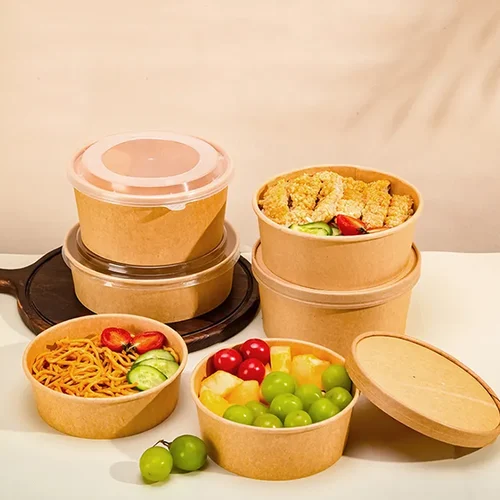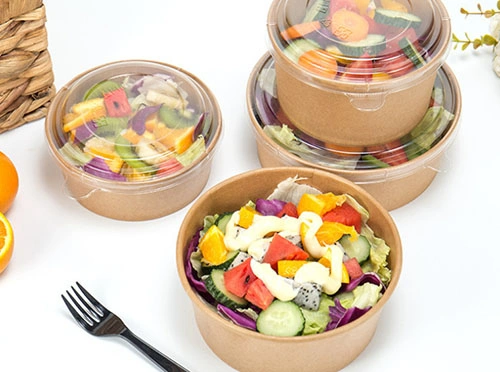Choosing the right salad bowl size directly impacts portion size, presentation, and packaging. Whether you’re serving in a restaurant, delivering takeout, or making it for home, the right paper bowl can make your salad appear substantial and avoid waste. At our XiangGe factory, we manufacture a variety of salad bowls. In this guide, you’ll learn about recommended sizes for single servings, family portions, and bulk use.
Last updated: October 2025 | Estimated reading time: 8 minutes

This article will answer your questions
- What factors determine the size of a salad bowl?
- Recommended salad bowl sizes for single and family servings
- Takeout and restaurant salad bowl sizes
- Choose size based on salad type
- Packaging, shipping, and cost considerations
- Environmental protection and practical advice
What factors determine the size of a salad bowl?
Salad bowl size depends on a variety of factors: portion size, type of salad, presentation, and packaging. Lettuce salads are lighter than grains, so the calorie count for the same volume is different.
In North America, 24oz and 32oz salad bowls are the best-selling options. The 24oz size is ideal for lunch salads, the 32oz is suitable for dinner, and the 48oz is ideal for sharing or high-protein salads. The European market prefers 16oz–26oz sizes due to their smaller portion sizes and simpler packaging.
- Portion size: Choose the one that suits you best, whether it’s a snack, lunch, or dinner.
- Salad density: Pasta or grain salads are heavier, so it is recommended to choose a small salad bowl
- Visual Effect: Salad bowl should look full but not overflowing
What is the recommended size for a single-serving salad bowl?
Most single-serving salads use a 24oz bowl. This is perfect for serving a moderate portion without being too full, and is also suitable for takeout or family meals.
| Portion Type | Bowl Size | Advantage |
|---|---|---|
| Small side salad | 16oz | Compact, lightweight, eco-friendly |
| Standard lunch salad | 24oz | Fits mixed greens and toppings |
| Main meal salad | 32oz | Enough space for grains and proteins |
Tip: Keep the bowl about 80% full to keep it nice and fresh.
What is the best salad bowl size for a family or shared meal?
Large bowls (32oz–48oz) are perfect for sharing. They can serve 2–4 people and are perfect for a high-protein salad.
Many restaurants use just two sizes—small (24oz) and large (32–48oz)—to simplify inventory and SKUs.
What ounce size should you choose for a takeout salad bowl?
Takeout bowls need to balance portion size, avoid spillage, and be stackable. 24oz and 32oz are the most commonly used.
- Matching lids (diameter 115mm, 150mm, 185mm)
- Sealer compatibility (height and edge thickness)
- Portion control (80% fill guaranteed fresh)
Helpful tip: Test your salad bowls before ordering in bulk.
What salad bowl size do restaurants recommend?
Restaurants focus on serving speed and customer experience. Most chain restaurants choose two or three sizes:
- Small: 16oz–24oz, for side dishes or light meals
- Medium: 32oz, for main meals
- Large/Sharing: 42oz–48oz, for family or party use
Industry Insight: Standardized sizes reduce inventory, ensure lids match, and reduce packaging waste.
How to choose bowl size based on salad type?

Different types of salads require different volumes:
- Vegetable or fruit salad: Lightweight, 24oz or 32oz salad bowls are recommended
- Pasta or grain salad: Dense, a 16oz–26oz bowl is sufficient
- High-protein salad: Chicken, tuna, etc., preferably in a 32oz–42oz bowl
It is recommended that you test each salad type with the bowl, 80% filling is optimal.
Does sala bowl size affect packaging and storage space?
Yes, bowl size affects:
- Carton packing efficiency: The number of large bowls is small, which will increase shipping costs
- Shelf and refrigerator space: Large bowls take up more space
- Material thickness: The actual available volume of a double-layer bowl is smaller than that of a single-layer bowl
Eco friendly tip: Medium sizes (24oz–32oz) offer a balance between portion size, material usage, and stackability, saving packaging.
Salad bowl packaging trends in 2025
- Sustainable materials: biodegradable paper, compostable coating
- Simple packaging: The European market prefers small bowls and less ingredients
- Standardized dimensions: simplify logistics, lid matching, and cost calculation
- Focus on fill ratio and presentation: appearance becomes part of the brand experience
Key trends:
- Environmental protection first: 24oz–32oz is the most practical
- Pre-tested portions: Reduce returns and waste
- Customizable lids and closures: suitable for takeout and delivery
FAQs
A 24oz bowl is the most commonly used; test the salad to ensure it fits.
Not necessarily. Use a small bowl for dense salads and a large bowl for light salads.
24oz and 32oz are most suitable for box packing, which can reduce transportation costs and improve stacking efficiency.
Conclusion
16oz – Small side dish
24oz – Standard lunch salad
32oz – Large or for two people
48oz – Party or share
Next steps: Determine target portion sizes and salad types. Test the bowl and lid combination before ordering in bulk. Focus on customer experience and packaging efficiency.
About XiangGe Package
We specialize in paper salad bowls and food packaging for restaurants and retail customers. With experience exporting to North America, Europe, and Australia, we can help you choose the right bowl size to optimize portion size, presentation, and shipping efficiency. Our eco-friendly solutions and standardized sizes reduce costs and improve sustainability.
Get free samples or custom bowl solutions.
Last updated: October 2025
Recommended internal links:

